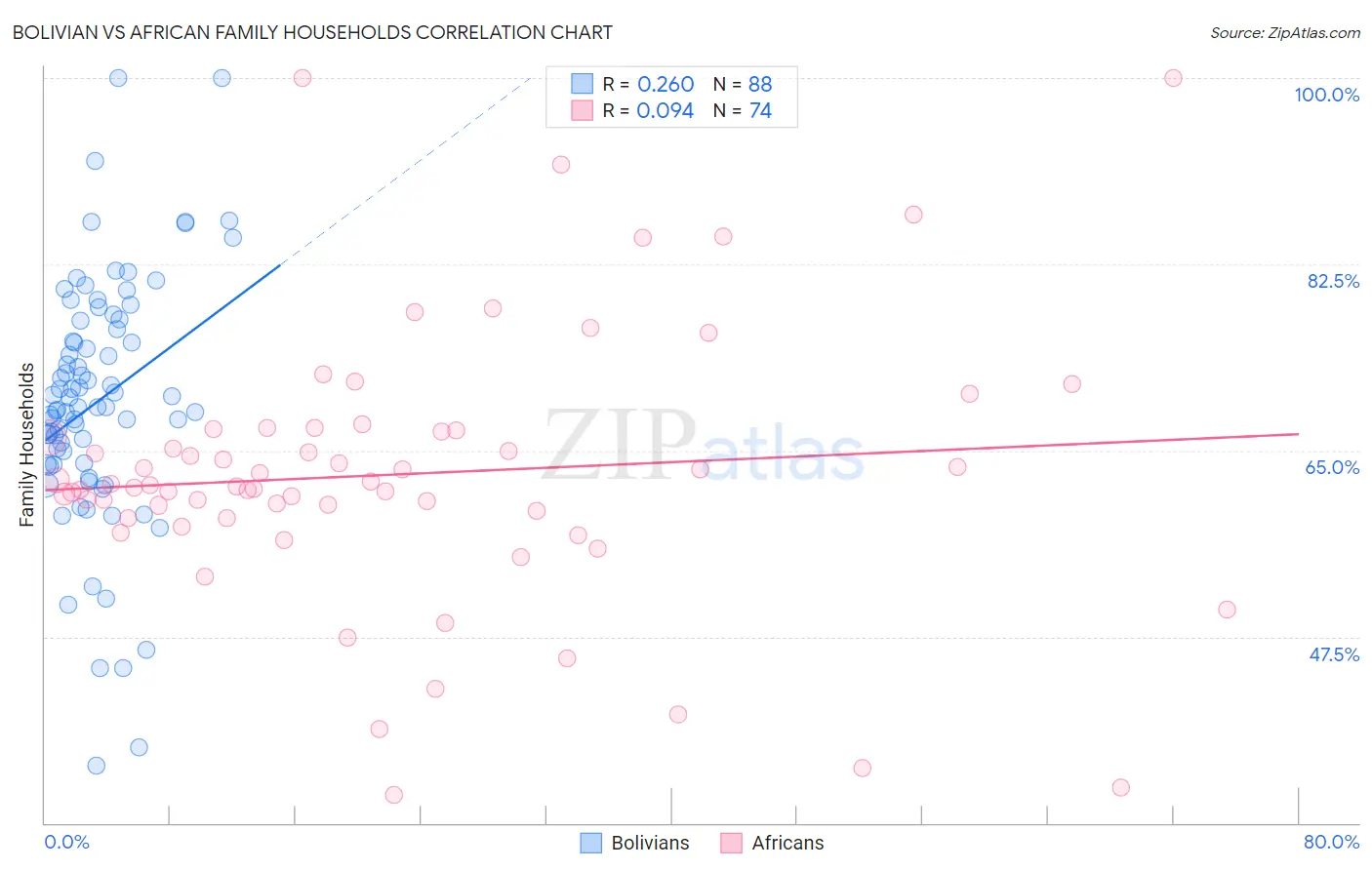Bolivian vs African Family Households
COMPARE
Bolivian
African
Family Households
Family Households Comparison
Bolivians
Africans
66.5%
FAMILY HOUSEHOLDS
100.0/ 100
METRIC RATING
47th/ 347
METRIC RANK
62.1%
FAMILY HOUSEHOLDS
0.0/ 100
METRIC RATING
306th/ 347
METRIC RANK
Bolivian vs African Family Households Correlation Chart
The statistical analysis conducted on geographies consisting of 184,628,552 people shows a weak positive correlation between the proportion of Bolivians and percentage of family households in the United States with a correlation coefficient (R) of 0.260 and weighted average of 66.5%. Similarly, the statistical analysis conducted on geographies consisting of 469,598,671 people shows a slight positive correlation between the proportion of Africans and percentage of family households in the United States with a correlation coefficient (R) of 0.094 and weighted average of 62.1%, a difference of 7.0%.

Family Households Correlation Summary
| Measurement | Bolivian | African |
| Minimum | 35.4% | 32.6% |
| Maximum | 100.0% | 100.0% |
| Range | 64.6% | 67.4% |
| Mean | 69.6% | 62.8% |
| Median | 69.1% | 61.7% |
| Interquartile 25% (IQ1) | 63.8% | 58.7% |
| Interquartile 75% (IQ3) | 76.8% | 66.9% |
| Interquartile Range (IQR) | 13.1% | 8.2% |
| Standard Deviation (Sample) | 11.6% | 12.7% |
| Standard Deviation (Population) | 11.5% | 12.7% |
Similar Demographics by Family Households
Demographics Similar to Bolivians by Family Households
In terms of family households, the demographic groups most similar to Bolivians are Immigrants from Venezuela (66.4%, a difference of 0.020%), Arapaho (66.5%, a difference of 0.030%), Venezuelan (66.5%, a difference of 0.050%), Asian (66.5%, a difference of 0.070%), and Immigrants from South Central Asia (66.4%, a difference of 0.070%).
| Demographics | Rating | Rank | Family Households |
| Guamanians/Chamorros | 100.0 /100 | #40 | Exceptional 66.6% |
| Immigrants | Bolivia | 100.0 /100 | #41 | Exceptional 66.6% |
| Menominee | 100.0 /100 | #42 | Exceptional 66.5% |
| Apache | 100.0 /100 | #43 | Exceptional 66.5% |
| Asians | 100.0 /100 | #44 | Exceptional 66.5% |
| Venezuelans | 100.0 /100 | #45 | Exceptional 66.5% |
| Arapaho | 100.0 /100 | #46 | Exceptional 66.5% |
| Bolivians | 100.0 /100 | #47 | Exceptional 66.5% |
| Immigrants | Venezuela | 100.0 /100 | #48 | Exceptional 66.4% |
| Immigrants | South Central Asia | 100.0 /100 | #49 | Exceptional 66.4% |
| Navajo | 100.0 /100 | #50 | Exceptional 66.4% |
| Natives/Alaskans | 100.0 /100 | #51 | Exceptional 66.4% |
| Colombians | 100.0 /100 | #52 | Exceptional 66.3% |
| Afghans | 100.0 /100 | #53 | Exceptional 66.3% |
| Immigrants | Colombia | 100.0 /100 | #54 | Exceptional 66.3% |
Demographics Similar to Africans by Family Households
In terms of family households, the demographic groups most similar to Africans are Bermudan (62.2%, a difference of 0.020%), Immigrants from Norway (62.1%, a difference of 0.080%), Chippewa (62.1%, a difference of 0.080%), Subsaharan African (62.1%, a difference of 0.14%), and Iroquois (62.2%, a difference of 0.17%).
| Demographics | Rating | Rank | Family Households |
| Immigrants | Kuwait | 0.0 /100 | #299 | Tragic 62.4% |
| Immigrants | Africa | 0.0 /100 | #300 | Tragic 62.4% |
| Immigrants | Albania | 0.0 /100 | #301 | Tragic 62.4% |
| Immigrants | Kenya | 0.0 /100 | #302 | Tragic 62.3% |
| Cree | 0.0 /100 | #303 | Tragic 62.3% |
| Iroquois | 0.0 /100 | #304 | Tragic 62.2% |
| Bermudans | 0.0 /100 | #305 | Tragic 62.2% |
| Africans | 0.0 /100 | #306 | Tragic 62.1% |
| Immigrants | Norway | 0.0 /100 | #307 | Tragic 62.1% |
| Chippewa | 0.0 /100 | #308 | Tragic 62.1% |
| Sub-Saharan Africans | 0.0 /100 | #309 | Tragic 62.1% |
| Immigrants | Liberia | 0.0 /100 | #310 | Tragic 62.0% |
| Immigrants | Morocco | 0.0 /100 | #311 | Tragic 62.0% |
| Immigrants | Latvia | 0.0 /100 | #312 | Tragic 62.0% |
| Liberians | 0.0 /100 | #313 | Tragic 62.0% |